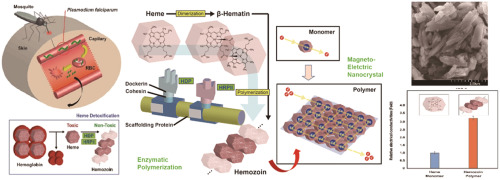Biosensors and Bioelectronics ( IF 10.7 ) Pub Date : 2018-05-10 , DOI: 10.1016/j.bios.2018.05.007 Jeong Eun Hyeon , Da Woon Jeong , Young Jin Ko , Seung Wook Kim , Chulhwan Park , Sung Ok Han

|
Regardless of the malaria disease risk, the malaria parasite Plasmodium falciparum has an interesting mechanism. During its growth within the red blood cell, toxic free heme is converted into an insoluble crystalline form called the malaria pigment, or hemozoin. In particular, natural hemozoin nanocrystals can provide multiple applications in biosensing fields for health care and diagnosis as similar to artificial metal nanoparticles. In this study, the heme was biologically synthesized and polymerized by Corynebacterium glutamicum and final polymer was applied as a biomimetic conductive biopolymer. The biosynthesized monomer heme by metabolic engineered strain was enzymatically polymerized by an enzyme complex containing two different heme polymerization proteins. Moreover, the electrical conductivities of hemozoin prepared by heme polymerase enzyme complexes were investigated and compared with those of the heme monomer. Because of the synergetic effects of polymerized heme, synthesized artificial nanocrystals exhibited a greater conductive property than a heme monomer. As a result of their surpassing properties, developed novel magnetoelectric nanocrystals could be motivated as smaller scale electronic devices with advanced properties. Thus, these results will open a brand new field in the frontier of the heme detoxification mechanism of the malaria parasite and its biomimetic application as advanced nanomaterials for biological and biomedical sensing.
中文翻译:

血红素聚合制备的仿生磁电纳米晶体,作为生物传感应用的高级纳米材料
不论疟疾风险如何,疟原虫恶性疟原虫都有一个有趣的机制。在其在红细胞内的生长过程中,有毒的游离血红素转化为不溶的晶体形式,称为疟疾色素或血红素。尤其是,天然的血红蛋白纳米晶体可以像人工金属纳米粒子一样,在生物传感领域提供多种应用,用于健康护理和诊断。在这项研究中,血红素是由谷氨酸棒杆菌生物合成和聚合的最终的聚合物被用作仿生导电生物聚合物。由代谢工程菌株生物合成的单体血红素通过包含两种不同血红素聚合蛋白的酶复合物进行酶促聚合。此外,研究了血红素聚合酶复合物制备的血红素的电导率,并将其与血红素单体的电导率进行了比较。由于聚合的血红素的协同作用,合成的人工纳米晶体显示出比血红素单体更大的导电性能。由于其卓越的性能,开发的新型磁电纳米晶体可被激发为具有先进性能的小规模电子设备。因此,











































 京公网安备 11010802027423号
京公网安备 11010802027423号